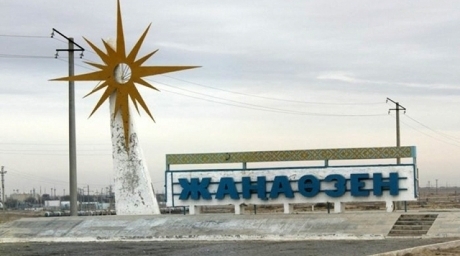
Lessons Learned and Public Accountability in Kazakhstan After Zhanaozen
Publication: Eurasia Daily Monitor Volume: 9 Issue: 22
By:

On January 31, the state of emergency ended as scheduled in Zhanaozen, the oil town devastated on December 16 when an oil-workers’ strike degenerated into riots. Most of the town’s public edifices and business establishments were attacked in one way or another, looted and set on fire that day. The inexperienced police, itself a target of rioters, panicked initially, then reacted with indiscriminate force in some cases. Ultimately, 16 rioters were killed and more than 100 people were injured (including some bystanders and 35 policemen) in the December 16 chaotic melee. The state of emergency introduced the following day helped pacify the situation, which stabilized soon thereafter. Parliamentary elections were held in Zhanaozen as throughout the country on January 15, with a 60 percent turnout in the town and numerous election observers present (see EDM, January 18). With the end of the state of emergency on January 31, internal troops and armored vehicles have withdrawn and checkpoints were removed from Zhanaozen.
The government of Kazakhstan has initiated a lessons-learned process with public accountability from the outset of these events. The process is moving on five parallel tracks: prosecuting organizers and main perpetrators of the violent riots; investigating cases of unlawful use of force by police; uncovering corruption among local administration and oil company officials; re-training and re-employing workers who were dismissed or lost their jobs in Zhanaozen’s declining oil industry; and centrally funding a reconstruction and development program for this depressed, single-industry town. Zhanaozen (and, to a degree, the Mangistau region in which it is located) poses a set of local problems that cannot be extrapolated to other regions (let alone country-wide), but with ramifications and lessons learned that are relevant to reform efforts at the national level.
The Prosecutor-General’s Office has released progress reports on the investigation at regular intervals to the media. As of January 25 it brought charges against six suspected organizers, 11 suspected arsonists and looters, and 23 identified as “active participants” in the Zhanaozen violence.
Additionally, three are charged as organizers and 12 as active participants in attacking the railway station and tearing out the tracks in Shtepe (also in Mangistau region). In both places, rioters used Molotov cocktails, improvised blank weapons and clubs, and occasionally shotguns (Interfax-Kazakhstan, January 25).
Also by January 25, the Prosecutor-General’s Office had opened criminal cases against the deputy chiefs of police of the Mangistau region and Zhanaozen town, and three other senior police officers. Most of these are charged with disproportionate use of force, including unlawful use of live ammunition. One of these officers is being prosecuted in connection with the beating and death of a man (apparently a bystander) while in police custody. The police veterans’ union and, apparently, some on active duty feel that prosecution of those officers is unfair, since they had no experience with such situations and were themselves under attack: “What were they to do?” (Interfax-Kazakhstan, January 26).
Such sentiment might seem to indicate a risk of demoralizing the police. However, the government seems set to launch a reform of the law enforcement apparatus. In his annual, state-of-the-country address on January 27, President Nursultan Nazarbayev announced that all law-enforcement agencies’ officers would have to undergo re-certification (facing possible replacement) by July 1, on a country-wide basis (Kazinform, January 27).
The former and the incumbent mayors of Zhanaozen, as well as two managers of KazMunayGas Exploration and Production, and another pair of managers from OzenMunayGas are being prosecuted on charges of embezzling funds allocated by these oil companies for social programs. Two foundation administrators running those program were criminally charged in the same case. Politically, these officials and managers can be said to have contributed to social tensions, prolonging the strike as a collateral effect of diverting the funding from social programs (Interfax-Kazakhstan, January 31). It might also amount to discovering but a tip of the corruption’s iceberg.
The need to reform the labor legislation is a further lesson learned. According to the Mangistau region’s newly appointed governor, Baurzhan Muhammedzhanov (a former justice minister and former presidential administration head), the Labor Code is flawed and outdated. Muhammedzhanov expresses a common view among Kazakhstani officials that the country needs viable trade unions with authentic labor leaders in the interest of stable social relations. This institution has yet to be developed in Kazakhstan (Vremya, January 19).
From the moment of introducing the state of emergency in Zhanaozen (December 17), President Nazarbayev had instructed the government to form an inter-departmental commission for assistance to the riot-devastated Zhanaozen, whose oil industry has been declining along with the local oil reserves. The chairman of Samruk-Kazyna National Welfare Fund, Umirzak Shukeyev, chairs this commission. It oversees Zhanaozen’s ongoing recovery and has drafted a reconstruction and development plan for 2012-2015. On the labor side, the program envisages re-training and re-employing workers (pre-eminently the dismissed oil workers) at new enterprises to be opened in Zhanaozen and elsewhere. Some 2,000 applications have been submitted thus far (Kazinform, January 31).
Government ministers are expected to arrive in Zhanaozen on working visits with the end of the state of emergency. The Kazakhstani media is also expected to turn up. Writing in a US foreign policy journal, Minister of Foreign Affairs Yerzhan Kazykhanov encourages the international press to visit and report from Zhanaozen (Foreign Policy [Washington], January 26).




